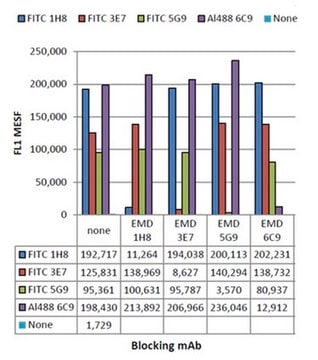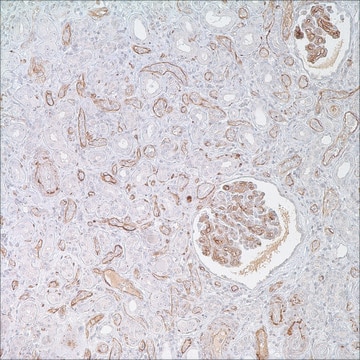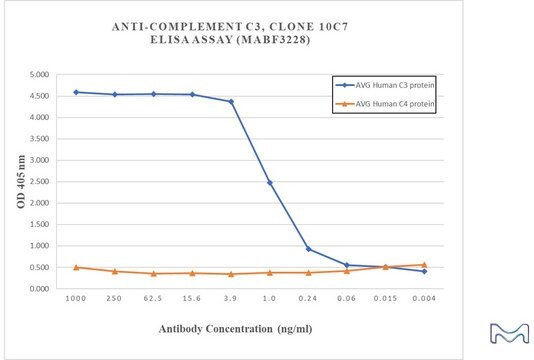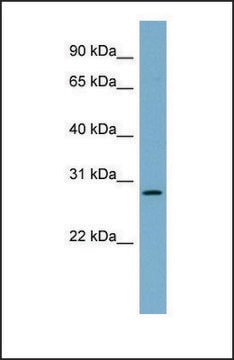MABF972
Anti-Complement C3b/iC3b Antibody, clone 3E7, neutralizing
clone 3E7, from mouse
Synonym(e):
Complement C3, C3 and PZP-like alpha-2-macroglobulin domain-containing protein 1, Complement C3 beta chain, C3-beta-c, C3bc, Complement C3 alpha chain, C3a anaphylatoxin, Acylation stimulating protein, ASP, C3adesArg, Complement C3b alpha′ chain, Complem
About This Item
Empfohlene Produkte
Biologische Quelle
mouse
Qualitätsniveau
Antikörperform
purified immunoglobulin
Antikörper-Produkttyp
primary antibodies
Klon
3E7, monoclonal
Speziesreaktivität
human, primate
Methode(n)
flow cytometry: suitable
immunocytochemistry: suitable
neutralization: suitable
Isotyp
IgG1κ
NCBI-Hinterlegungsnummer
UniProt-Hinterlegungsnummer
Versandbedingung
wet ice
Posttranslationale Modifikation Target
unmodified
Angaben zum Gen
human ... C3(718)
Allgemeine Beschreibung
Spezifität
Immunogen
Anwendung
Entzündung & Immunologie
Immunoglobuline & Immunologie
Flow Cytometry Analysis: A presentive lot detected C3b/iC3b deposit on anti-CD20 mAb Rituximab-opsinized human peripheral blood ARH-77 & Raji B cells, as well as Rituximab-opsinized CD20+ cells freshly isolated from monkey blood (Kennedy, A.D., et al. (2003). Blood. 101(3):1071-1079).
Immunocytochemistry Analysis: A presentive lot detected C3b/iC3b deposit on anti-CD20 mAb Rituximab-opsinized human peripheral blood ARH-77 & Raji B cells, as well as Rituximab-opsinized CD20+ cells freshly isolated from monkey blood (Kennedy, A.D., et al. (2003). Blood. 101(3):1071-1079).
Qualität
Zielbeschreibung
Physikalische Form
Lagerung und Haltbarkeit
Handling Recommendations: Upon receipt and prior to removing the cap, centrifuge the vial and gently mix the solution. Aliquot into microcentrifuge tubes and store at -20°C. Avoid repeated freeze/thaw cycles, which may damage IgG and affect product performance.
Sonstige Hinweise
Haftungsausschluss
Not finding the right product?
Try our Produkt-Auswahlhilfe.
Lagerklassenschlüssel
12 - Non Combustible Liquids
WGK
WGK 2
Flammpunkt (°F)
Not applicable
Flammpunkt (°C)
Not applicable
Analysenzertifikate (COA)
Suchen Sie nach Analysenzertifikate (COA), indem Sie die Lot-/Chargennummer des Produkts eingeben. Lot- und Chargennummern sind auf dem Produktetikett hinter den Wörtern ‘Lot’ oder ‘Batch’ (Lot oder Charge) zu finden.
Besitzen Sie dieses Produkt bereits?
In der Dokumentenbibliothek finden Sie die Dokumentation zu den Produkten, die Sie kürzlich erworben haben.
Unser Team von Wissenschaftlern verfügt über Erfahrung in allen Forschungsbereichen einschließlich Life Science, Materialwissenschaften, chemischer Synthese, Chromatographie, Analytik und vielen mehr..
Setzen Sie sich mit dem technischen Dienst in Verbindung.








